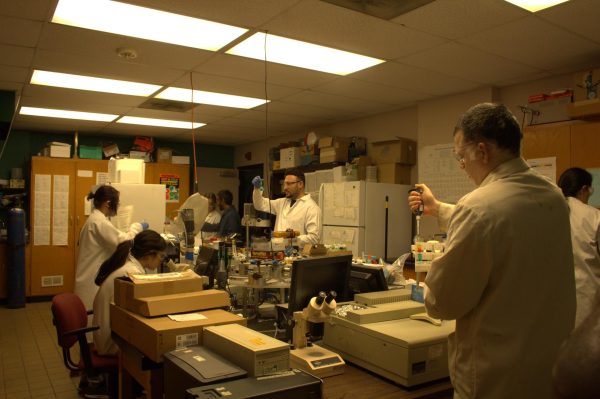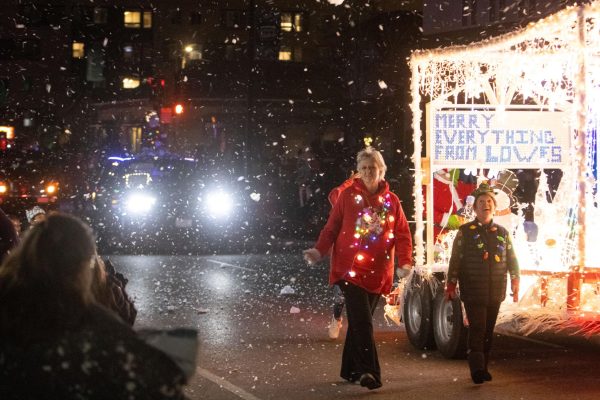Student workers are picking labor fights as a path to building stronger communities
Campus workers are on strike at Columbia University in New York right now, their second this year, and the second largest current strike in the country.
Media outlets have paid renewed attention to labor struggles in the past year, heralding a “strike wave”, a “Striketober” and more recently “Strikesgiving,” as workers in a variety of industries have taken action to improve their living conditions following the economic turmoil of the COVID-19 pandemic.
New York University workers went on strike in April, and won a tentative agreement raising starting pay to a whopping $26.
Advertisement
The trend toward worker action in higher education isn’t limited to New York schools.
This year, Graduate Workers Union at Illinois State University staged a series of protests, a hunger strike and authorized a labor strike to pressure the administration into offering better contract terms.
Northwestern University food workers’ strike authorization, coupled with support from Students Organizing for Labor Rights, secured employees’ terms for healthcare benefits and a $19.88 starting wage.
Actions are even happening in deep-red states, like neighboring Kentucky where campus workers in Lexington were able to push the base wage for campus workers up to $15 in a state where the minimum wage is still $7.25.
Worker demands have also gone beyond wages.
United Campus Workers of Alabama, based in Tuscaloosa, are hosting town halls to expand mental health resources, which are also massively backlogged at Southern Illinois University Carbondale.
Those actions are due in no small part to university administrators refusing accountability for basic human needs, like stable housing, food, safety and income. The additional pressure of COVID was really just the spark in the tinderbox.
Advertisement*
At SIU, it’s clear there’s something lacking that has kept campus workers from stopping work to press for better working conditions.
SIU has largely mismanaged the COVID crisis, refusing to release infection numbers for months, and dragging its feet providing safe, practical separation between infected and uninfected students and staff.
When Resident Assistants anonymously sounded the alarm on the school’s negligence, administrators threatened to fire employees.
GAU and the faculty union won limited safety protocols, but this fall the administration chose to let infection spread run rampant through campus, despite petitions from employees and students.
Those issues are on top of campus workers’ poverty wages, a cap on working hours that makes it difficult to access welfare services and overloaded counseling services in the wake of tragic student deaths.
The fact is, absent real pressure, the university doesn’t need to make concessions.
College towns, Carbondale included, are effectively company towns where a university is the solar center of the community and all other activity is drawn into its orbit.
As Davarian L. Baldwin outlines in his book, “In the Shadow of the Ivory Tower: How Universities are Plundering Our Cities,” universities exert control over local governments, employees, real estate markets and have their own police forces and healthcare industries.
For Southern Illinois University, that gravity extends beyond the city of Carbondale, and out across all of Southern Illinois.
The school contributed about $1.4 billion and 17,707 direct and indirect jobs to the regional economy annually, according to a 2011 economic impact study.
“As SIU goes, so goes Southern Illinois’ economy,” Reporter Molly Parker said in a 2016 article.
Unfortunately for community members, SIU administrators are comfortable paying employees the bare minimum in an extremely depressed region.
So it goes.
Being a supermajority economic driver in a city or urban neighborhood means, for many communities, gaining leverage over the spending and decision making of the local college is the only way for community members to take control of their own lives.
Campus workers in other parts of the country are coming to terms with that reality, and, in the last five years, launched one of the largest labor organizing drives in US higher education history.
Union organizing in education isn’t particularly new. Professors at Howard University, notably a historically Black institution, organized the first American Federation of Teachers union in 1918.
Recent union formations have a different character, though, as most are non-faculty.
A plurality are student workers, tired of their political energy being funneled into student programming committees, resident’s associations or student governments that have no binding power at their institutions.
Some groups, like United Campus Workers, are even organizing around a wall-to-wall model that represents all campus workers, uncommon among higher education institutions where employees of different classifications generally bargain separately.
New organizing in higher education is, in part, the result of a 2016 ruling by the National Labor Relations Board (NLRB) that “student teaching assistants” and “student research assistants” at private universities are, in fact, employees, and not just students that happen to get some money for working at their school.
At least 61 new bargaining units have formed since 2016, according to data gathered by Washington University, and at least a third of those were student workers’ unions.
Many Illinois colleges have been part of this wave, including Loyola, University of Chicago, Illinois State University and Northwestern University.
SIU’s sister school in Edwardsville, formed in 2018, is a part of this student worker wave. SIU’s own student worker union, Graduate Assistants United, which certified in 2006, was ahead of the curve.
Student worker organizing in the University of California system this year is likely to bring 30,000 new members into United Auto Workers (UAW).
It’s clear SIU needs a shift in favor of campus workers.
Unions for undergraduate student workers organized at Grinnell College in Iowa, George Washington University in Washington D.C. and Reed College in Oregon could be a model for empowering campus workers.
Even with additional workers organized, there would need to be more coordination and cooperation among all campus workers to fight for better conditions for everyone in the community.
Campus workers also need to be aware of, and stand in solidarity with, community struggles outside the university.
Like workers at UK, the SIU could rally around addressing safety by supporting youth initiatives at the Dentmon Center, healthy food systems through organizations like Carbondale Spring and expanding healthcare.
It’s only by working together that Southern Illinois can build a brighter future for itself.
Staff reporter Jason Flynn can be reached at [email protected] and on Twitter: @DEJasonFlynn. To stay up to date with all your Southern Illinois news, follow the Daily Egyptian on Facebook and Twitter.
Advertisement













